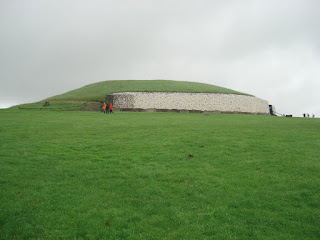
Since returning to Dublin following a week away, we have been spending time visiting local sites and learning about the city and the nation. And it has been fascinating.
First we went to an ancient site called Newgrange. Located in the valley of the river Boyne, about 45 minutes north of Dublin, it is one of the oldest signs of human habitation in Ireland. The site includes three large stone mounds, each with an inside passageway that opens onto a burial chamber. We took the official tour of the site and learned that scientists have been able to discover almost nothing about the people who built the mounds, who was buried in them, or why they were built in the shape they have. There is writing in the passageway but no one knows what it means. The mounds are dated about 3000 BC, but beyond that nothing much is certain. Fascinating.

We then went to Dublinia, the Viking center of Dublin, and learned about the Vikings and the city. It seems that at the city of Dublin first became a city with the arrival of the Vikings at the end of the eighth century, and for several centuries it remained as such—separated from the rest of the country, which was made up of feuding clans of Irish with loyalty to one of the several kings. Gradually the Vikings blended with the surrounding population, but they maintained their important merchant and trading positions. On Good Friday, 1014, internal struggles between the several Irish provincial rulers boiled over into a battle at a place called Clontarf, a battle in which the Vikings joined with the soldiers of the area around Dublin (Leinstermen). Romanticists identify this battle as the end of the Viking era in Irish history, but many would say that it was more an internecine battle with the Vikings playing a part, and in fact the Vikings remained as a significant force in Dublin itself for many more years.

The next era we looked at was represented by the Dublin castle. This era began with what is called the Norman Invasion of 1169, an event which some would prefer to label as the Norman Invitation as it technically began with the English responding to a request of an Irish leader for help in his political ambitions. In any case the English arrived, settled into Dublin, built the castle on the site of an earlier primitive fortification, and began a centuries-long gradual expansion into the whole of the island.

Through all of this history, with its various forces and factors, a common thread of Christianity is woven. St. Patrick’s Cathedral, the largest church in Ireland, was built in the thirteenth century, replacing a small wooden church that had stood on the site of a well that the famous saint is said to have used to baptize new believers in the middle of the fifth century.
 Christ Church Cathedral in Dublin was probably founded around 1030 , and in a rare arrangement shared the status of cathedral with St. Patrick’s. Following the disestablishment of the Catholic church in Ireland both have retained the status of cathedral in the Church of Ireland, while Rome maintains St. Mary’s church as a Pro-Cathedral in recognition of their claim on Christ Church as the rightful seat of the Catholic Archbishop.
Christ Church Cathedral in Dublin was probably founded around 1030 , and in a rare arrangement shared the status of cathedral with St. Patrick’s. Following the disestablishment of the Catholic church in Ireland both have retained the status of cathedral in the Church of Ireland, while Rome maintains St. Mary’s church as a Pro-Cathedral in recognition of their claim on Christ Church as the rightful seat of the Catholic Archbishop. 
At Clonmacnoise, a monastery to the east of Dublin founded by St. Cirian, we walked on paths and entered ruins of a holy site built in the middle of the sixth century. Throughout the Republic reminders of the place of religion in the history of the island, such as shrines, monastic sites, cathedrals and The Book of Kells, abound. And it has been both a task and an interesting journey to see and walk in some of those places.
The more I learn the more I see there is to learn. When we leave Ireland we will know more than when we came, but we will also be aware of new puzzles and big gaps in our understanding that we never knew we had before. I guess that is the way it is supposed to be. It is like our growth in Christ—the more we know about him the more we know we do not know. In The Chronicles of Narnia one of the children made this profound observation about Aslan, the great lion and ruler of Narnia, The closer I get (to him) the bigger he grows. I find that to be true—do you?

No comments:
Post a Comment